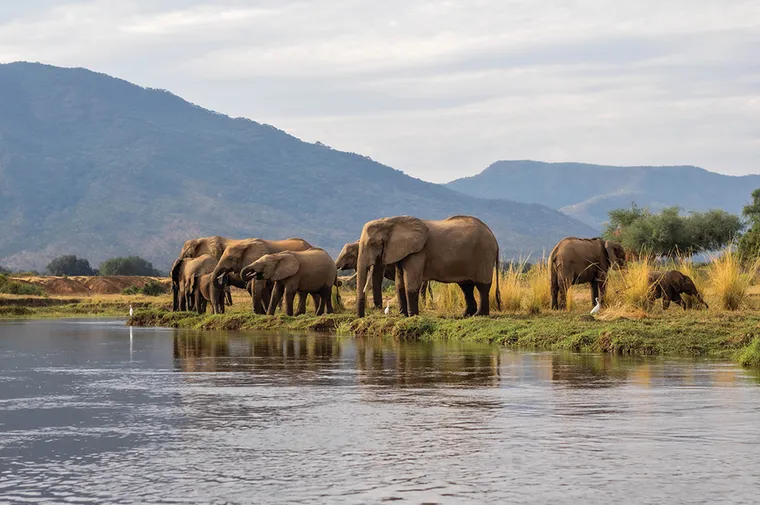South African-born writer Daniel Scheffler heads to Zambia to uncover the bush
Africa is so big, with 54 countries and almost a billion people. So, how does one choose where to go on safari? The country of Zambia, landlocked and hidden between some of her bigger sisters, is where the “walking safari” was invented, and thus, has a unique appeal to adventurous types. The word safari comes from the Arabic “Safar,” and it literally means “to journey”; here in Southern Africa, they like to say it means “going to the bush.”
Zambia is sub rosa. If you know about the bush and want to spend time with animals, away from the crowds that descend on so many safari locations, you come to Zambia. And if you’re interested in participating in a very adventurous walking safari, this is the place to do it. The “official” walking safari was introduced in Zambia by Norman Carr. He was a British conservationist who wanted to shift the focus away from hunting to photographic safaris. Soon after his efforts, the walking safaris popularity surged.
A Walk To Remember
So, what exactly does a walking safari entail? Besides a moment to log off from technology and find some stillness, it involves a strenuous walk deep into the wilderness.
On foot, you head out from your lush camp at dawn, with a pair of guides (they are armed with rifles, just in case, as per Zambian rules). They know the bush so well that recognizing every smell, sound, and spoor (track or scent of an animal) is second nature for them. There is something about having your feet in the dirt and your eyes glued to the paths and foliage that allows for a more intimate experience. Walking, as an alternative to the game drives in a Land Rover, has an essence of nature and an ability to remove distractions, placing you right alongside the animals.
Too, walking in the bush has its own kind of magic. You find little pitter-patter footsteps of a tiny mongoose, or you’ll see the dung of a rhino. Birds like the endemic barbet (who loves a good swamp) suddenly get up close and very personal. Perhaps this kind of safari is not traditionally adventurous, but it taps into a different sense of exploit and pleasure—one of the unexplored wild. You’re able to access places that 4x4s cannot, and you can find your thrills when you come upon a herd of buffalo grazing and ruminating, or elephants playing in the water with their young. Or some predators waiting to hunt for their dinner.

The most prized animals to spot in the wild are the Big Five: the lion, the leopard, the elephant, the buffalo, and the rhinoceros. When on a typical game drive safari, those are absolutely what you’d be able to see. But on a walking safari, you’re also able to see something totally unique (if you’re lucky and attentive)—the Little Five. In direct contrast in size, they all share part of their English name with the Big Five: the elephant shrew, the red-billed buffalo weaver, the leopard tortoise, the antlion, and the rhino beetle. Much harder to spot on a safari, the term “Little Five” came about as conservationists wanted to draw attention to smaller, less noticed, but no less enigmatic, animals of the bushveld.
Overall, the walking safari serves as the perfect romp into the wild. It’s a chance to sneak quietly up to large mammals as they go about their business. Your heart will be racing, and you’ll find a moment of stillness that only the African bush can offer. And because you’ll be thinking of how, at some point centuries ago, humans cohabitated with these animals, it will also force you to ponder conservation and its graveness.
Things To Keep In Mind As You Plan Your Bush Romp:
Where to go and with whom
The best way to do this is to book with family-owned Tide and Time Africa. They have various luxury lodges dotted around Zambia. Try Chinzombo (in the South Luangwa National Park), with luxury safari tents—with private pools —beneath ancient msikizi trees. Or in the lower Zambezi (which means “grand river”) at the Chongwe camp, where they also have the private Chongwe House with a pool the elephants like to use as a watering hole. Zambia is all about using the walking safari to see rather densely concentrated game, and Tide and Time Africa can arrange all of it. They also offer a sleep-out, during which you dine outside and then fall asleep under the stars.
When to go
It is true, you can go on safari year-round; however, the exact time of year will influence what game you will be able to spy, and the kind of weather you will experience. For Southern Africa, the dry season (May through October) is prime for game-viewing thrills, as the animals habitually congregate at watering holes for social and predatory reasons. However, in the wetter parts of the year, animals give birth; this is a period that’s idyllic for bird watching.

What to pack
There are often small bush planes that locals use to hop around various safari camps, so most important, pack light but sensibly. A hat with a wide brim is probably the most important item to pack, as the sun is tenacious but glorious. Wintertime requires a few comfortable layers—you’ll be happier on the early-morning game drives and during those evenings sitting at the bonfire. During summer, it can get rather warm, so think of light jackets, flip-flops, and clothing made from natural fabrics. For bush walks, a boot with ankle support is always a good idea. Most lodges are well-equipped with bug sprays, water bottles, sunscreens, and more, so save room in your bag for some handmade crafts to take home.
A few special things to know
Early mornings are when the bush is very active, as animals migrate, hunt, or stroll about looking for fun, so be prepared to rise before the sun and join a game drive. The African bush has its own rhythm, a meditation, if you will; allowing time away from schedules and deadlines comes with a reward, and the bush is the place to embrace it. There will be a moment when you’re sitting under the stars, around the boma (a sort of fire pit), listening to the wilderness all around you and telling stories—and this will force a reflection on our inch-perfect cycle of life.


